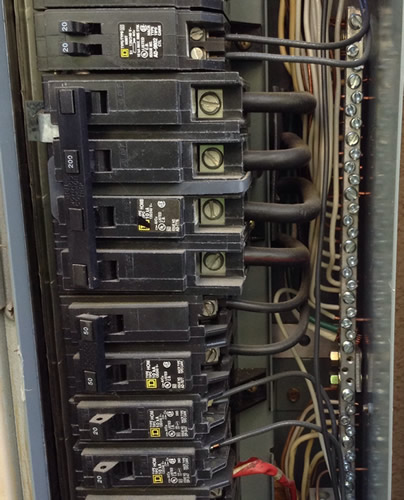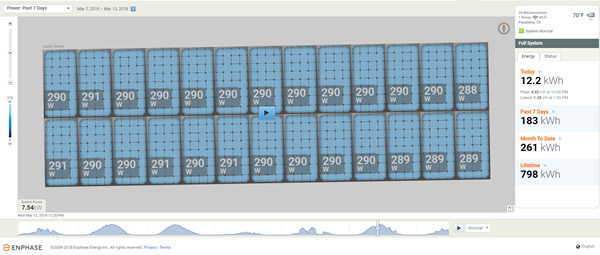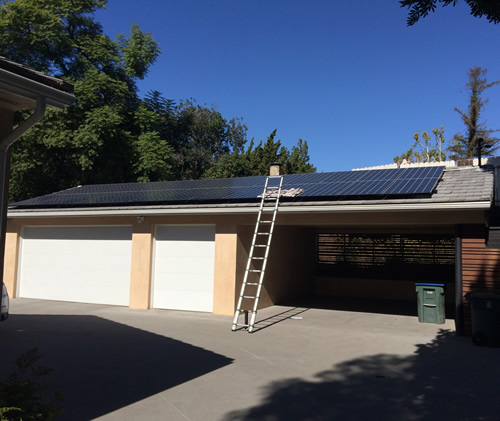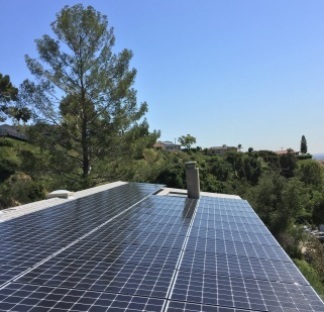Welcome to the
Run on Sun Monthly Newsletter

In this Issue: |
March, 2018
Volume: 9 Issue: 3
Sweet Relief - LA County Signs-off on Solar for Center-Fed Service PanelsDue to a misreading of the electrical code, many jurisdictions in the Run on Sun service area - and yeah, we are talking about you, LA County - balked at allowing homeowners to install solar if they were connecting to a center-fed panel. This has resulted in costly, and unnecessary service panel upgrades, and even prevented some homeowners from adding solar at all! Well good news - LA County has finally gotten with the program and agreed to interpret the code consistent with the intent of the code's authors. Here's the scoop....
For example, a couple of years ago, San Diego Gas & Electric introduced an adapter ring to fit between the meter socket and the service meter. Soon thereafter, SCE adopted a similar solution, and that became our "go-to approach" for center-fed panels in LA County. While County would sign-off on the SCE ring (or Generation Meter Adapter, as SCE called it), it was really an awful solution to the problem For one thing, SCE charged the homeowner just under $500 for the install, and their technician had to do the work in full arc-flash protection gear - a testament to the hazard involved. Beyond that temporary risk, the connection now left a pair of terminals in the solar disconnect with no over-current protection between them and the power pole transformer. Short that connection out, and nothing would stop that current from flowing until the wires melted! A better solution was recently brought to market in the form of the B3-Bypass breaker which we wrote about last Fall. The B3 fits into center-fed panels and provides a much safer way to interconnect solar than the GMA ring. But guess what? Despite it having passed UL certification, LA County will not accept it, as we learned when we attempted to submit plans calling for the installation of the B3! So, back to square one? Well not quite. While on the phone with County's plan checker, I remembered that a code amendment had been passed effective a year ago January, that clarified the intent of the code when it comes to center-fed panels. We had cited this amendment to County last year, only to be told that County had not yet approved the amendment - hence we installed multiple GMA rings with center-fed panels last year. Here's the language of the amendment: A connection at either end, but not both ends, of a center-fed panelboard in dwellings shall be permitted where the sum of 125 percent of the power source(s) output circuit current and the rating of the overcurrent device protecting the busbar does not exceed 120 percent of the current rating of the busbar. This is what we had been saying all along, and the code amendment makes it clear that this is an acceptable thing to do - as well as being cheaper and safer than any of the alternatives. So, I asked the plan checker, had County gotten any closer to adopting this amendment? "Oh," said the plan checker, "we've been accepting it since January, 2017!" Sigh. So not true. At least none of the plan checkers that we encountered in 2017 were accepting the amendment. And for that matter, this plan checker did not volunteer the information. Instead, he was about to sign-off on the GMA ring without ever bothering to mention that there was a safer and cheaper way for us to meet the needs of our client! Is it too much to ask that a plan checker point out policy changes of which s/he is aware when discussing plans with a contractor? Here's the bottom line: If your solar project meets the interconnection requirements set forth in the quoted language above, you do not need to upgrade your panel, and you don't need a GMA ring to attach solar to your center-fed panel in LA County territory. (And if it satisfies LA County, presumably every other jurisdiction should go along as well.) If you need documentation - either as a homeowner to provide to your solar contractor who is trying to sell you an unwanted service panel upgrade - or as a solar contractor trying to convince a recalcitrant AHJ - here's the link to the California Building Standards Bulletin that approves the amendment, and here is Bill Brooks' write-up explaining the need and justification for the amendment. The fact that several thousand center-fed panels in good repair have required replacement over the past two years when, in fact these upgrades are unnecessary, presents a real and unnecessary hazard to the field workers required to perform these replacements. Any time a service equipment replacement is performed on a dwelling, utility service must be interrupted and significant electrical work must be performed to replace the equipment. This exposes the electrical worker to hazards of potentially live conductors and inadvertent errors that could even be fatal. The hazards of these upgrades is appropriate when the existing service equipment is damaged or has outlived its useful safe operating life. Performing these upgrades on perfectly good equipment that is not a safety hazard to the dwelling is an unnecessary risk. We couldn't agree more! |
“Performing these upgrades on perfectly good equipment that is not a safety hazard to the dwelling is an unnecessary risk.”
Get your copy of
Commercial Solar:
Step-by-Step
from
Run on Sun
Founder & CEO
Jim Jenal

Now available on Amazon.com
in both
Print & Kindle versions.
Bonus - Buy the Print version…
Get the
Kindle version for Free!
Commercial Solar:
Step-by-Step
from Run on Sun
Founder & CEO
Jim Jenal

Now available on Amazon.com
in both Print & Kindle versions.
Get the Kindle version for Free!
Help Us Spread the News!


Problem Solving 101 - "I lost the map!"At Run on Sun we like to think of ourselves as true Solar Pros - years of experience, NABCEP certified, yadda, yadda, yadda! But this post is about doing something wrong (nicely done, Jim) and having to figure out a way to fix it (thank you, Sara!). We recount it here because it might help some of our colleagues who just might make the same mistake! Run on Sun is a huge Enphase shop, and one of the reasons why is the great monitoring that we get for every installation. For installers, we can see module-level data that allows us to determine not only if there is a problem with the array, but where that problem is! (Contrast this with a string array, where determining where a problem resides can be an error-prone and time-consuming process.) The answer is easy - each microinverter has an associated serial number, and it sends that serial number to the monitoring device (called an Envoy) when it reports its performance. When the installer "builds" the array in the cloud, she maps the serial numbers from the microinverters to the layout as installed. To facilitate that mapping, Enphase provides a peel-off label on each microinverter. The installer removes the sticker and places it on a map, to be pared with the online layout. When we are doing our installs, I am often the person responsible for collecting the labels onto the map, and then later using that map to build the system online. I've been doing this for years, and never had a problem. Until the other day. I got back to the office, ready to build out our array online, only to discover - there's no map! Mind you, I remember clearly creating the map, and I would have sworn I put it in the car right after doing so, but it was nowhere to be found! Yikes! Now what do we do? To be sure, the serial number were still on the microinverters, but they could not be read from where they are located on the roof! Ugh - we could remove the modules (of our otherwise operational system) but that would be a huge amount of work - there has got to be a better way! Cue Sara - Problem Solver Extraordinaire!(Oh, and we now take a picture of the map as soon as it is completed!) So there you go folks, live and learn! If anyone out there has faced this problem in the field, how did you resolve it? We would love to hear from you! |
Rethinking the "Cost" of SolarWe hear a lot about the "cost" of solar when utilities attempt to weaken net metering rules. "Solar is only for the wealthy," they say. "Poorer ratepayers subsidize every rooftop solar installation out there." "Why should the poorest ratepayers help pay for a more affluent person's solar system?" Yes, you hear these claims a lot - generally with little or no data to back it up. But you know what? We just got some real data about the cost of solar, and it might change this whole discussion. Stick around... The CalISO Board just adopted their latest spending plan and that is where things get interesting! In the CalISO press release, the Board agreed to cancel or modify 39 previously approved transmission projects, avoiding an estimated $2.6 billion in future costs! That is some serious coin - how did this happen? It turns out that we all did it together - here's what the Board noted:
So let's go back to that whole, "cost" of solar thing. It seems that thanks to the investments made by hundreds of thousands of individual homeowners throughout the state, installing solar power systems funded mostly out of their own pockets, all ratepayers are getting to share in the return on that investment. Moreover, this is not a one-time return; those systems with 20+ year life expectancies will continue to help avoid additional infrastructure costs for the next couple of decades. Which explains why some utilities are not so thrilled by these results. Turns out that the Investor-Owned Utilities (or IOUs, specifically SCE, PG&E, SDG&E) make their money through rates that are based on providing a guaranteed rate of return on built assets - like transmission lines. Build fewer transmission lines (or power plants for that matter) and there is a smaller asset base from which to derive that return. The ratepayers save money, the shareholders of the IOUs make less money. Oops. So... the next time someone starts squawking about how resi solar is "installed on the backs of the poor" you might point out that actually, we are saving folks a bunch of money, all the while making the world a greener place! |





